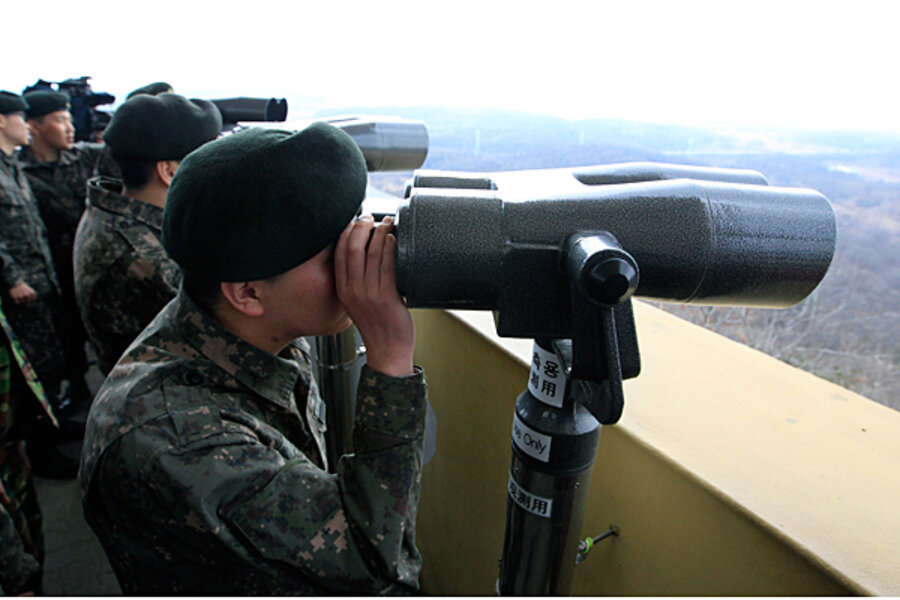North Korea missile test: What's a Musudan?
Loading...
| Washington
North Korea appears set to conduct a missile test at any moment. That’s what South Korea’s Foreign Minister Yun Byung-se told lawmakers on Wednesday, saying the prospect of such a launch is “considerably high.”
April 15, next Monday, might be the date around which the test would take place. That’s the day North Korea marks the birthday of founder Kim Il-sung, and the Pyongyang regime often puts on a display of some sort of military might around that time.
The main weapon involved appears to be the “Musudan,” an intermediate-range ballistic missile named by the United States after the town near which North Korea has a testing range.
“As has been widely reported ... there’s been a Musudan movement to the east coast,” Adm. Samuel Locklear, commander of US Pacific Command, told the Senate Armed Services Committee on Tuesday.
A Musudan has a minimum range of about 400 miles and a maximum range of about 3,500 miles, Locklear said. That means it could not reach the US mainland or Hawaii.
“I assume, if it was pointed in that direction, it could put Guam at risk. But let me reiterate again: We’ve got the capability in place to monitor and to be able to protect the homeland, protect Guam, and protect our forces that are fielded there as well as our allies,” said Locklear, referring to American missile defenses in the region.
If North Korea does in fact test-fire a Musudan, the US and its allies will reap at least one large intelligence benefit. The launch could settle a debate within the expert community about the Musudan’s capabilities – or whether the missile exists at all. That’s because as far as is known, Pyongyang has never tested the missile in real flight.
The Musudan is a road-mobile intermediate-range ballistic missile that physically resembles a 1960s-era Soviet submarine missile named the SS-N-6. Reports of its existence first appeared in the Western press in the mid-2000s. The world outside North Korea got its first good look at the Musudan in 2010, when it took part in a military parade in Pyongyang.
The US is pretty sure North Korea has had access to SS-N-6 technology, because of reports that members of the Soviet design bureau that produced the missile have traveled to Pyongyang, wrote nuclear and proliferation expert Jeffrey Lewis last year on his Arms Control Wonk blog. Some of that technology appears to have been used in other North Korean long-range missiles, and perhaps in Iranian weapons. According to news reports, North Korea sold Iran a number of SS-N-6 kits in 2005.
For the Musudan, “[a]ll that is missing is a flight test," wrote Mr. Lewis, who is director of the East Asia program at the James Martin Center for Nonproliferation Studies. "Of course, there are rumors that Iran tested the missile for North Korea.”
A Musudan missile based on SS-N-6 technology would represent a huge technical advance for North Korea’s arsenal. Most of Pyongyang’s short- and medium-range ballistic weapons are based on old Soviet Scud technology. The SS-N-6, however, has a much more advanced engine and uses propellants that pack much more energy than does Scud fuel. Its airframe is light and fragile.
“Though being an almost 50-year-old design, the [SS-N-6] missile’s technology is still close to the technical limits, and its performance is state-of-the-art,” German missile-technology expert Markus Schiller wrote in a RAND Corp. report on the North Korean missile threat.
Look at it this way: A Musudan is about the same launch weight as North Korea’s Scud-based Nodong missile, but has more than twice the range. It’s a Ferrari where the Nodong is an old pickup truck.
But Mr. Schiller is not convinced that the Musudan missile is in fact North Korea’s version of the Soviet sub weapon. Among pieces of evidence, the warheads that Pyongyang has displayed on Musudans in parades match the SS-N-6 warhead too exactly, he notes.
The Soviet warhead is nuclear, and it was designed by a separate organization. North Korea almost certainly does not have it. That could mean Pyongyang is trying to fool the US and its allies into believing North Korean missiles are more advanced than they are.
“It seems more plausible to assume that North Korea is still limited to Scud technology at best, than to assume that North Korea has mastered the SS-N-6 technology,” wrote Schiller and fellow German technology expert Robert H. Schmucker in a 2012 paper on North Korean missile designs.
A Musudan missile test could settle this question, albeit in a highly provocative manner.








